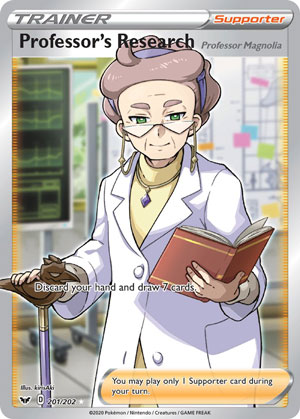
Professor’s Research – Sword & Shield
Date Reviewed: January 1, 2020
Ratings Summary:
Standard: 5.00
Expanded: 4.50
Limited: 5.00
Theme: 4.50
Ratings are based on a 1 to 5 scale. 1 is horrible. 3 is average. 5 is great.
Reviews Below:

Vince
Concluding the Top 10 of 2020 is none other than Professor’s Research Magnolia from Sword & Shield (with a Juniper version eventually coming), a case of a card having an identical effect but under a different name as well as a complex ruling in Expanded that you cannot have Professor’s Research, Professor Juniper, and Professor Sycamore in the same deck. Otherwise, it does the job well since day one as it lets you discard your hand and draw 7 cards.
This effect is very powerful for a Supporter card and also sets the bar on other Supporters to see if they worth using them over the Professor in that specific turn. The draw 7 effect is a very good amount to draw reliably, and although discarding your hand hurts, players try to mitigate them the best they can, using as many cards as then can before ultimately discarding them.
Professor’s Research is one of the cards where nearly every deck needs to run, and fortunately, most Theme Decks from the Sword & Shield series provides them several copies of Professor’s Research for them to use.
Ratings:
5 out of 5 (Standard, Expanded, Limited, Theme, and Legacy)
Yeah, not much for me to say about Professor’s Research because such cards been a staple for years and I have burned out explaining the history of “discard and draw 7” cards from older reviews from the Pojo site. You can ctrl-F “Professor Sycamore” or “Professor Juniper” and at least one of the links will show, one of them having Sycamore as the best card lost to rotation in 2018.

Otaku
Our number one pick for the best cards of 2020 is Professor’s Research (Sword & Shield 178/202, 201/202, 209/202; Champion’s Path 062/073)! It was also our number one pick from Sword & Shield. Professor’s Research should be a familiar sight to just about anyone reading this in the present, unless they have little to know familiarity with the game. This Trainer-Supporter has you discard your hand, then draw seven cards. Yes, you can still play Professor’s Research if your hand is otherwise empty, and that becomes a huge swing. On the opposite extreme, you could be forced to discard a rather massive hand, one far larger than seven cards, to play Professor’s Research in a given turn. Remember how I often warn you about how increasing or decreasing damage only really matters when it alters how many turns it takes to score a KO, or if it triggers or avoids triggering a particular effect?
Same deal here; drawing cards is about getting what you need into your hand, sometimes while bypassing or feeding into particular card effects. Plus the added concern of decking out; usually not an issue, but late game it really can matter. Professor’s Research provides a massive, reliable bit of draw power, but at a potentially painful cost. Even if your hand isn’t too late, it ranges from possible to probably you’ll have to discard something you don’t want in the discard pile, and cannot recycle. Fortunately, the nature of the PTCG is such that well-made decks are usually efficient, reliable decks. This means cards that can easily be played under most circumstances and/or with sufficient redundancies for when something is unfortunately wasted, Prized, etc… but which themselves are spares when no such problems have occurred. There are even many effects which reward you for having a particular card in your discard pile.
When you put that all together, the discard cost is usually a minor inconvenience that is sometimes a minor advantage. A select few decks can even turn it into a major advantage, but many slower decks or those with combos that require cards be played at specific times and/or in a specific order, that discard cost is actually pretty painful. As opposed to diminishing the potency of Professor’s Research, however, it usually hurts that deck’s competitive performance instead. Professor’s Research is heavily used in competitive play play, usually appearing at three or four in a deck, though some archetypes actually have to make do without it (some Welder decks). It also isn’t hard to obtain: the Professor Magnolia version of Professor’s Research has been included in all of the Sword & Shield-era Theme Decks, at either a two or three count.
Version? As with Boss’s Orders, you’ll see a “subtitle” or whatever you want to call it underneath the red “Supporter” label in the upper right hand corner of the card, opposite the card’s actual name. Currently, we only have the Professor Magnolia version, but a version with Professor Juniper in the art (and Professor Juniper’s name in the corner) have already been revealed. Personally, I’m hoping all the “Professor” characters, even the really obscure ones I probably don’t know about, get their own version of this card. This does bridge to another aspect of Professor’s Research we need to address; its not-so-hidden history. While Professor’s Research is a new cards, its roots go back to the days of Base Set.
The first set of the Pokémon TCG contained Professor Oak, and his effect was to discard your hand and draw seven cards. He is actually more powerful than Professor’s Research, because he is not a Trainer-Supporter. Supporters weren’t invented until a couple years (and several, several sets) later. Some of the other Supporters from the past, like Bill and Erika, were re-released as Supporters, which made the older versions illegal to use or were accompanied with errata or rulings stated the originals were to be treated as if they had the same stats/effects as the latest printing. Professor Oak hasn’t been reprinted since Base Set 2 (the fourth PTCG set in North America), where it was still a “normal Trainer”, so he functions as a Trainer-Item in the Unlimited Format to this day.
Before they released Professor’s Research, we received Professor Juniper in the Black & White-era and Professor Sycamore for the XY-era. They are Supporters, just like Professor’s Research and they still have the exact same effect as well. They were also as influential in Standard during their day, and remain staples in Expanded. However, there is a rule that you cannot mix Professor Juniper, Professor’s Research, and Professor’s Sycamore in the same deck. So no decks with 12 discard-your-hand-and-draw-seven Supporters, or even decks with four total but mixing them together. You can run four copies of just Professor Juniper, or just Professor’s Research, or just Professor Sycamore. The rule was originally created when Professor Sycamore first released, and applied to both Standard and Expanded. It made sense then.
Now? I don’t like specialty rules such as this. It is why many players have to ask if two cards with the same stats and effects except for different names count against the same four-card limit. Keep It Super Simple principle, ya know? The catch is that there isn’t a super simple option left. There’s the current cumbersome rule. There’s the option of issuing an errata for the older cards like this, so they all count as Professor’s Research. I’d love to see Professor Oak slip into that group, and see what happens to the Unlimited Format because of it, but even if not, I really like that option… unless I’m in charge of deck checks at a tournament. Then it becomes such a massive headache, where even I feel bad for having suggested it. The last option is to just do away with the rule; if someone wants 12 such cards in their Expanded Format deck, let them. I’m warming up to that idea; I don’t really see that being a problem anymore, though there might be a “sweet spot” of five to eight such cards that could still be an issue.
Speaking of Expanded, Professor’s Research is great there, but I actually have to score it lower here than in Standard. Thanks for Professor Juniper, Professor Sycamore, and that rule, Professor’s Research just gives you an alternate aesthetic for the same decks and strategies. I don’t have any recent data for Expanded, but the main thing is this is the Format where you still have Tapu Lele-GX, you still have VS Seeker, you still have several other powerful draw and/or search Supporters, and you even still have a lot of powerful, Ability-based draw. This is just barely enough for me to round down for Professor’s Research. In the Limited Format, if you pull Professor’s Research, you run it. It might backfire if you don’t get it until late game (your deck is only 40 cards), or when you’ve got too many good things you can’t afford to toss in hand, but you still run it and are better off for having it.
The Theme Format is similar. As stated earlier, any SW-era deck you run has two or three copies of Professor’s Research. Most have at least some limited form of recycling for certain cards, but what they lack are shuffle-and-draw Supporters. Why is that a problem? This is where you really feel having to discard your hand. That doesn’t make Professor’s Research a bad card, and technically they could have designed the Theme Decks so that this wasn’t a concern, but first-hand experience has shown how much it matters to this card, so I’m scoring it accordingly.
Ratings
- Standard: 5/5
- Expanded: 4/5
- Limited: 5/5
- Theme: 4/5
Professor’s Research is the the best draw card we have in Standard, and joins the other two best draw cards we have in Expanded. That doesn’t mean it is perfect, even when I’m awarding it a five-out-of-five, but Professor’s Research is way, way up there. Professor’s Research was “only” my 3rd-Place pick, but as I’ve repeatedly stated this week, any card from the top five has a legitimate claim to the number one spot. I asked myself how the game would be different if Professor’s Research hadn’t been printed, and while it would Standard would have been dramatically different, Expanded wouldn’t even notice. That was enough for Quick Ball to edge out both Boss’s Orders and Professor’s Research.
We would love more volunteers to help us with our Card of the Day reviews. If you want to share your ideas on cards with other fans, feel free to drop us an email. We’d be happy to link back to your blog / YouTube Channel / etc. 😉Click here to read our Pokémon Card of the Day Archive. We have reviewed more than 3500 Pokemon cards over the last 17+ years!



